Oldsmobile Cutlass Supreme 1994 Owner's Manuals
Manufacturer: OLDSMOBILE, Model Year: 1994, Model line: Cutlass Supreme, Model: Oldsmobile Cutlass Supreme 1994Pages: 276, PDF Size: 14.73 MB
Page 211 of 276
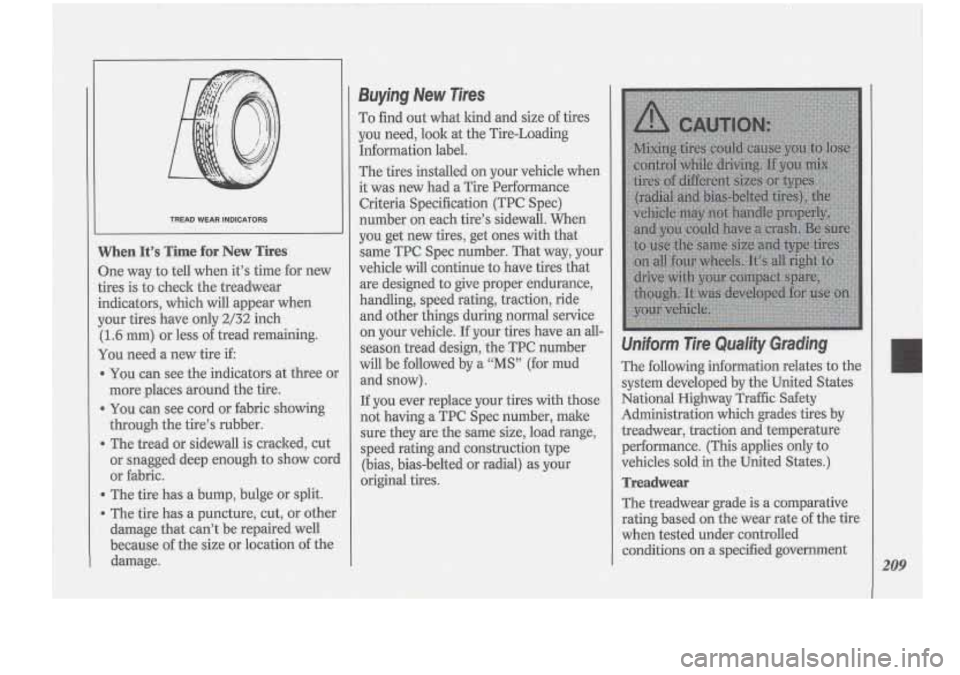
Page 212 of 276
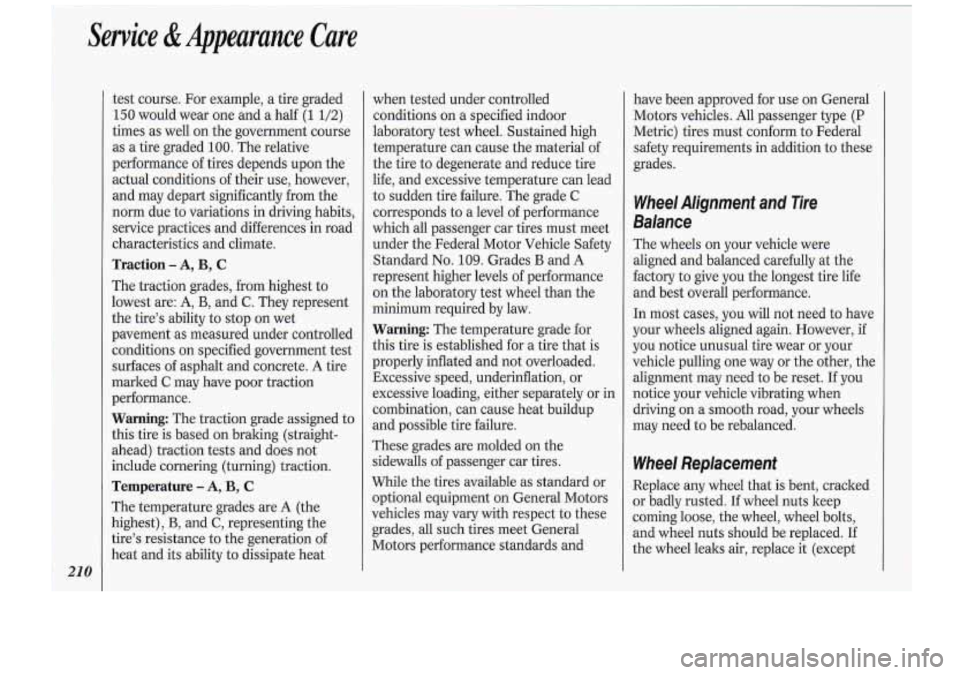
Service & Appearance Care
test course. For example, a tire graded
150 would wear one and a half (1 1/2)
times as well on the government course
as a tire graded
100. The relative
performance of tires depends upon the
actual conditions
of their use, however,
and may depart significantly from the
norm due to variations in driving habits,
service practices and differences
in road
characteristics and climate.
Traction - A, B, C
The traction grades, from highest to
lowest are:
A, B, and C. They represent
the tire’s ability to stop onwet
pavement as measured under controlled
conditions on specified government test
surfaces of asphalt and concrete.
A tire
marked
C may have poor traction
performance.
Warning: The traction grade assigned to
this tire is based on braking (straight-
ahead) traction tests and does not
include cornering (turning) traction.
Temperature - A, B, C
The temperature grades are A (the
highest),
B, and C, representing the
tire’s resistance to the generation of
heat and its ability to dissipate heat when
tested under controlled
conditions on a specified indoor
laboratory test wheel. Sustained high
temperature can cause the material of
the tire to degenerate and reduce tire
life, and excessive temperature can lead
to sudden tire failure. The grade
C
corresponds to a level of performance
which all passenger car tires must meet
under the Federal Motor Vehicle Safety
Standard
No. 109. Grades B and A
represent higher levels of performance
on the laboratory test wheel than the
minimum required by law.
Warning: The temperature grade for
this tire is established for a tire that is
properly inflated and not overloaded.
Excessive speed, underinflation, or
excessive loading, either separately or in
combination, can cause heat buildup
and possible tire failure.
These grades are molded
on the
sidewalls
of passenger car tires.
While the tires available as standard or
optional equipment on General Motors
vehicles may vary with respect to these
grades, all such tires meet General
Motors performance standards and have been
approved for use on General
Motors vehicles.
All passenger type (P
Metric) tires must conform to Federal
safety requirements in addition to these
grades.
Wheel Alignment and Tire
Balance
The wheels on your vehicle were
aligned and balanced carefully at the
factory to give you the longest tire life
and best overall performance.
In most cases, you will not need to have
your wheels aligned again. However,
if
you notice unusual tire wear or your
vehicle pulling one way or the other, the
alignment may need to be reset.
If you
notice your vehicle vibrating when
driving on a smooth road, your wheels
may need to be rebalanced.
Wheel Replacement
Replace any wheel that is bent, cracked
or badly rusted. If wheel nuts keep
coming loose, the wheel, wheel bolts,
and wheel nuts should be replaced. If
the wheel leaks air, replace it (except
Page 213 of 276
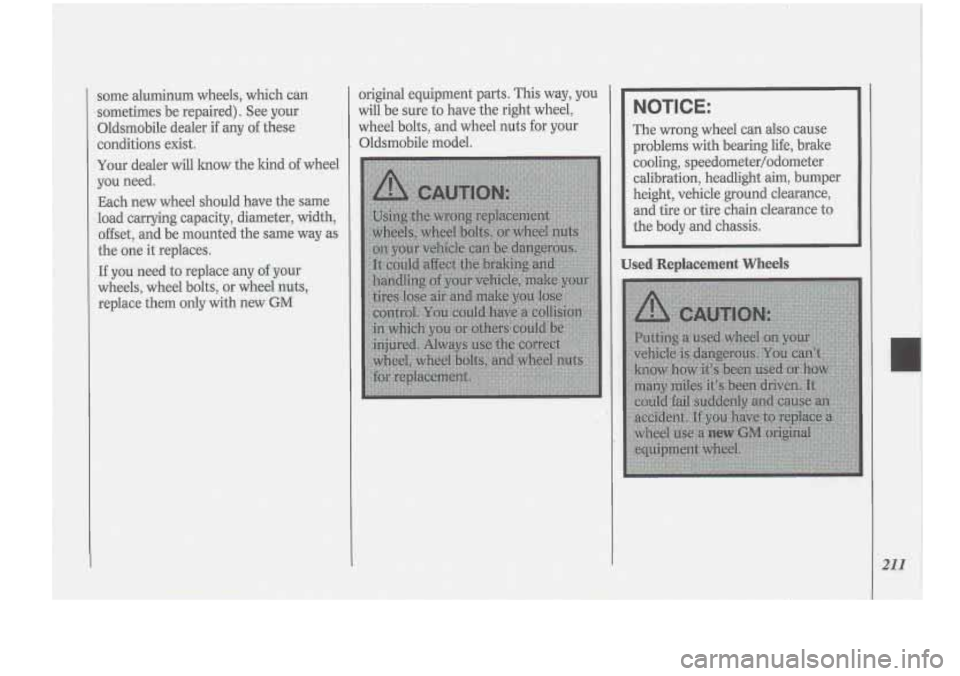
original equipment parts. This way, you
willbe sure to have the right wheel,
wheel bolts, and wheel nuts for your
Oldsrnobile model.
Page 214 of 276
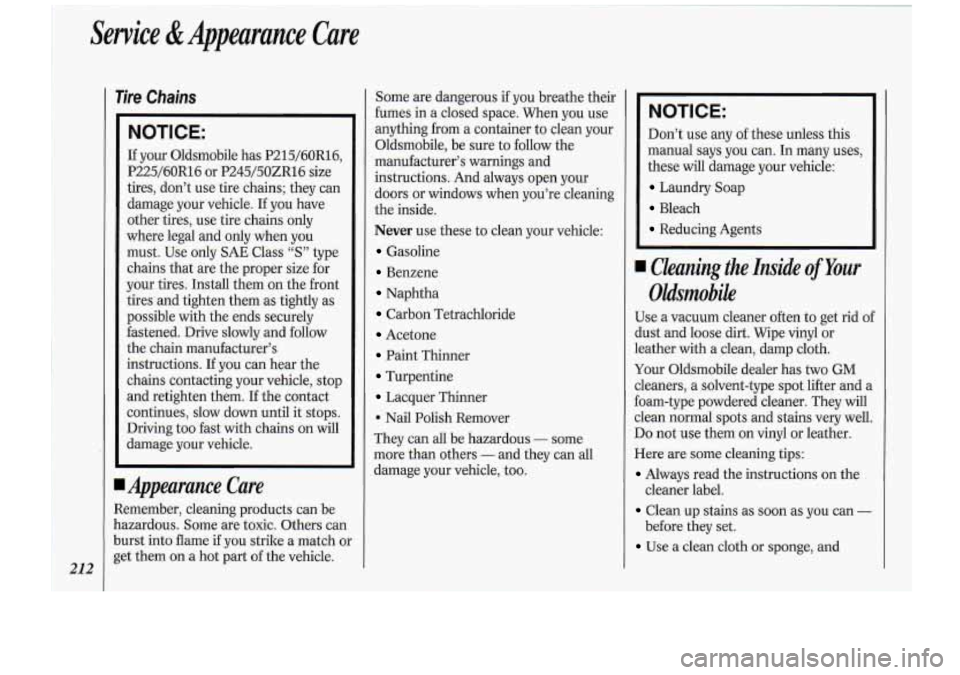
Tire Chains
NOTICE:
If your Oldsmobile has P215/60R16,
P225/60R16 or P245/50ZR16 size
tires, don’t use tire chains; they can
damage your vehicle.
If you have
other tires, use tire chains only
where legal and only when you
must. Use only SAE Class
“S” type
chains that are the proper size for
your tires. Install them on the front
tires and tighten them as tightly as
possible with the ends securely
fastened. Drive slowly and follow
the chain manufacturer’s
instructions. If you can hear the
chains contacting your vehicle, stop
and retighten them. If the contact
continues, slow down until it stops.
Driving too fast with chains on will
damage your vehicle.
I Appearance Care
Remember, cleaning products can be
hazardous. Some are toxic. Others can
burst into flame if you strike a match or
get them on a hot part of the vehicle. Some
are dangerous if you breathe their
fumes in a closed space. When you use
anything from a container to clean your
Oldsmobile, be sure to follow the
manufacturer’s warnings and
instructions. And always open your
doors or windows when you’re cleaning
the inside.
Never use these to clean your vehicle:
Gasoline
Benzene
Naphtha
Carbon Tetrachloride
Acetone
Paint Thinner
Turpentine
Lacquer Thinner
. Nail Polish Remover
They can all be hazardous
- some
more than others
- and they can a
damage your vehicle, too.
111
NOTICE:
Don’t use any of these unless this
manual says you can. In many uses,
these will damage your vehicle:
Laundry Soap
Bleach
Reducing Agents
I Cleaning the Inside of lbur
Oldsmobile
Use a vacuum cleaner often to get rid of
dust and loose dirt. Wipe vinyl or
leather with a clean, damp cloth.
Your Oldsmobile dealer has two
GM
cleaners, a solvent-type spot lifter and a
foam-type powdered cleaner. They. will clean normal spots and stains very well.
Do not use them on vinyl or leather.
Here are some cleaning tips:
Always read the instructions on the
Clean up stains as soon as you can -
Use a clean cloth or sponge, and
cleaner
label.
before they set.
Page 215 of 276
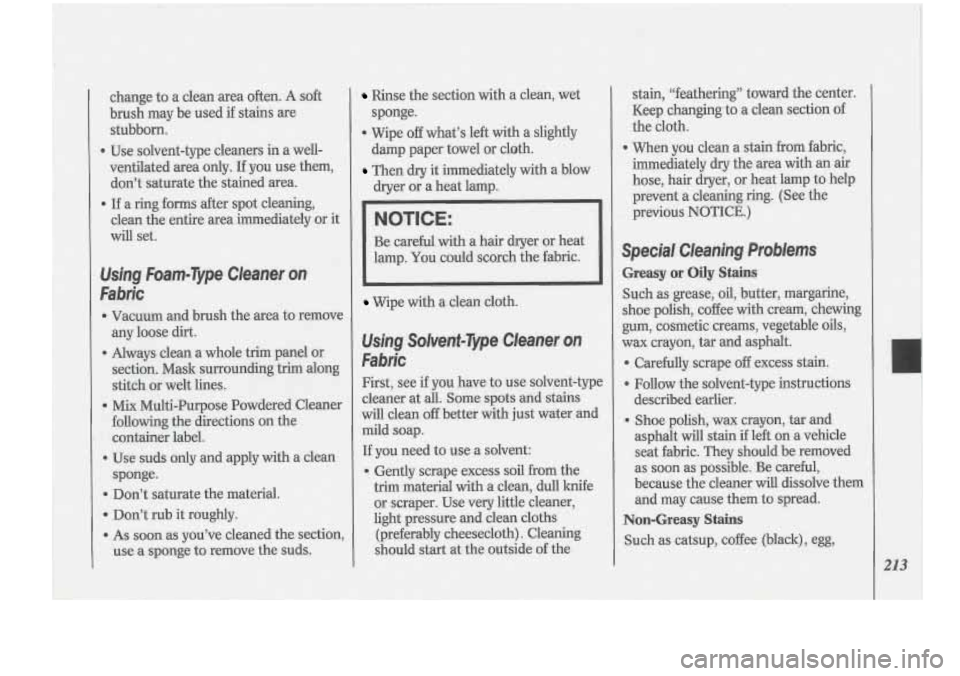
Rinse the section with a clean, wet
0 Wipe off what's left with a slightly
Then dry it immediately with a blow
sponge.
damp
paper: towel
or clsth.
dryer or a heat lamp.
.NOTICE:
Ek careful with a hair dryer or heat
lamp. You could scorch the fabric.
Wipe with a.clean cloth.
Using: SolvenbType Cleaner on
Fabric
First, see if you have to use solvent-type
dearrer at
all; Some spots and stains
.will clean
off. better with just water and
mild soap.
If you need to use a solvent:
0 Gently scrape excess soil 'from the
trim material with ,a clean,
dull knife
or scraper.
Use very little cleaner,
light pressure and clean cloths
(pre€erably cheesecloth). Cleaning
should start at the outside
of the
Page 216 of 276
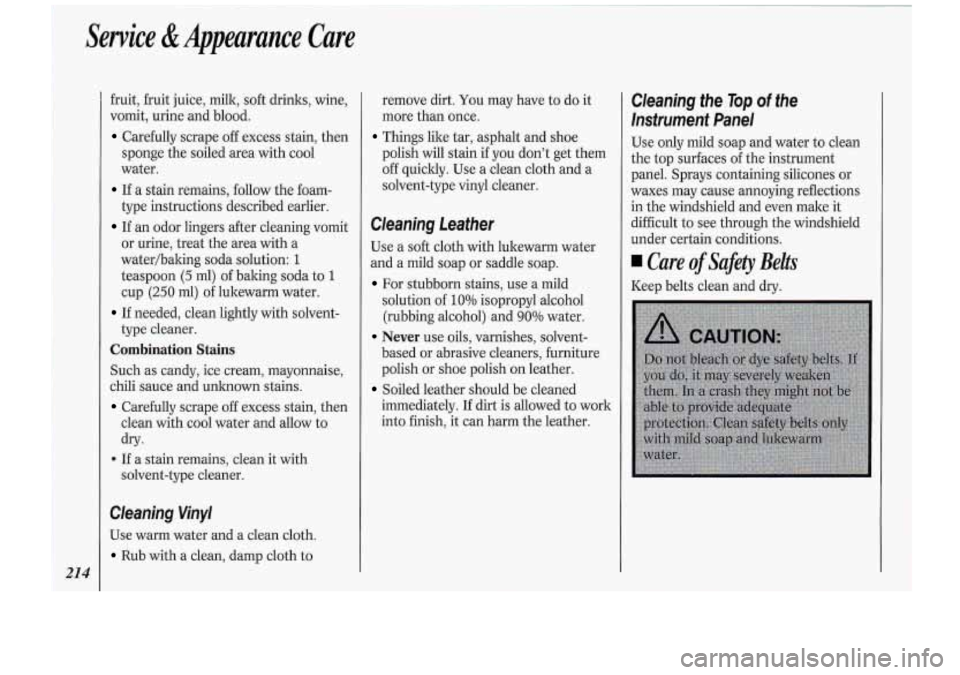
Service &Appearance Care
21 4
fruit, fruit juice, milk, soft drinks, wine,
vomit, urine and blood.
Carefully scrape off excess stain, then
sponge the soiled area with cool
water.
If a stain remains, follow the foam-
type instructions described earlier.
If an odor lingers after cleaning vomit
or urine, treat the area with a
waterbaking soda solution:
1
teaspoon (5 ml) of baking soda to 1
cup (250 ml) of lukewarm water.
If needed, clean lightly with solvent-
type cleaner.
Combination Stains
Such as candy, ice cream, mayonnaise,
chili sauce and unknown stains.
Carefully scrape off excess stain, then
clean with cool water and allow to
dry-
* If a stain remains, clean it with
solvent-type cleaner.
Cleaning Vinyl
Use warm water and a clean cloth.
Rub with a clean, damp cloth to remove
dirt.
You may have to do it
more than once.
Things like tar, asphalt and shoe
polish will stain
if you don’t get them
off quickly. Use a clean cloth and a
solvent-type vinyl cleaner.
Cleaning Leather
Use a soft cloth with lukewarm water
and a mild soap or saddle soap.
For stubborn stains, use a mild
solution of
10% isopropyl alcohol
(rubbing alcohol) and
90% water.
Never use oils, varnishes, solvent-
based or abrasive cleaners, furniture
polish or shoe polish on leather.
Soiled leather should be cleaned
immediately. If dirt is allowed to work
into finish, it can harm the leather.
Cleaning the Top of the
Instrument Panel
Use only mild soap and water to clean
the top surfaces
of the instrument
panel. Sprays containing silicones or
waxes may cause annoying reflections
in the windshield and even make it
difficult to see through the windshield
under certain conditions.
Care of Safety Belts
Keep belts clean and dry.
Page 217 of 276
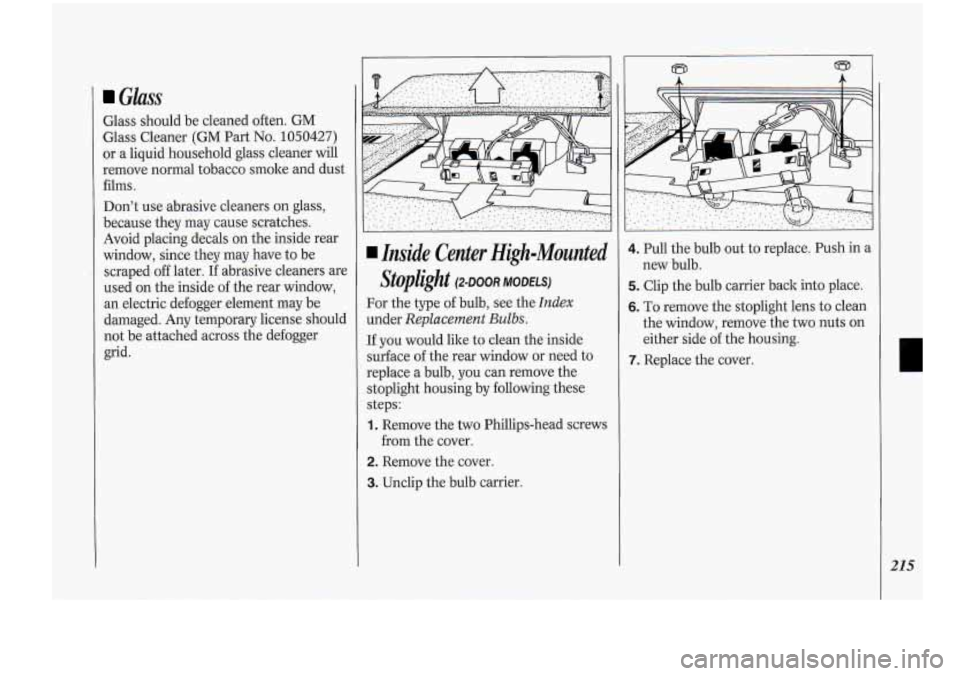
Glass
Glass should be cleaned often. GM
Glass Cleaner
(GM Part No. 1050427)
or a liquid household glass cleaner will
remove normal tobacco smoke and dust
films.
Don't use,abrasive cleaners on glass,
because they may cause scratches.
Avoid placing decals on the inside rear
window, since they may have. to be
scraped-
off later. If abrasive cleaners are
used on the inside of the rear window,
an electric defogger element may be
damaged. Any temporary license should
not be attached across the defogger
grid.
1 Inside Center High-Mounted
Stoplight
(2~00~ MODELS)
For the type of bulb, see the Index
under Replacement Bulbs.
If you would like to clean the inside
surface of the rear window or need to
replace a bulb, you can remove the
stoplight housing by following these
steps:
1. Remove the two Phillips-head screws
from the cover.
2. Remove the cover.
3. Unclip the bulb carrier.
4. Pull the bulb out to replace. Push in a
5. Clip the bulb carrier back into place.
.6. To remove the stoplight lens to clean
the window, remove the two nuts on
either side of the housing.
new
bulb.
7. Replace the cover.
215
Page 218 of 276
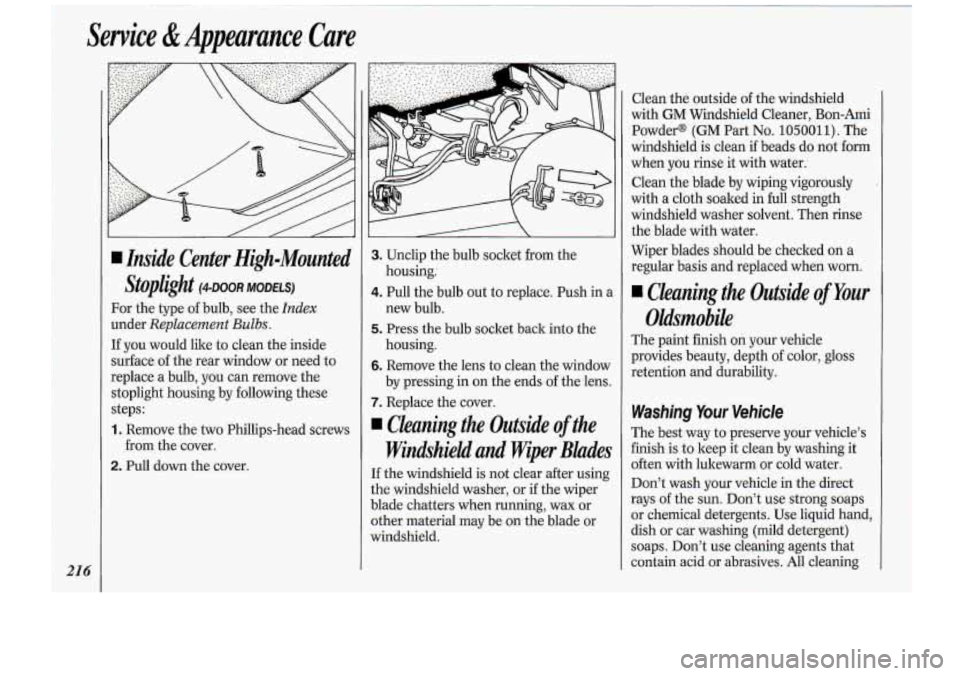
Service & Appearance.Care
Inside Center High-Mounted
Stoplight
(4.~00~ MODELS)
For the type of bulb, see the Index
under Replacement Bulbs.
If you would like to clean the inside
surface of the ,rear window or need to
replace a bulb., you can remove the
stoplight housing by following these
steps:
1 Remove the two Phillips-head screws
2. Pull down the cover.
from
the cover.
1
3. Unclip the bulb socket from .the
housing;
4. Pull the bulb out to replace. Push in a
.new bulb.
5. Press the bulb socket back into the
housing.
6. Remove the lens to clean the window
by pressing in on-the endsof the-lens.
7. Replace the cover.
Ckaning the-Outside of the
Windshield and Wiper Blades
If the windshield is not clear after using
the windshield washer, or
if the wiper
blade chatters when
running, wax or
other material may be.on.the blade or
windshield.
Page 219 of 276
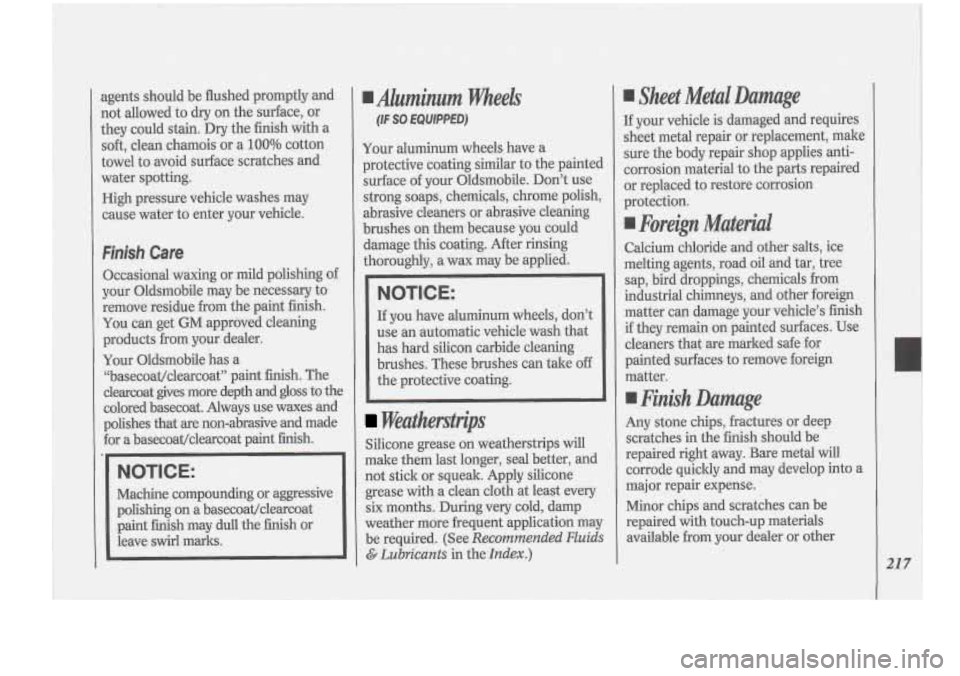
NOTICE:
Machine compounding or aggressive polishing
on a basecoat/clearcoat
.paint finish may dull the finish or
leave
swirl marks.
Aluminum Wpzeek
(IF SO. EQUlPPf D)
Weatherstrips
Silicone grease on weatherstrips will
make them last longer,
seal better, and
not stick- or squeak. Apply silicone
grease with a clean cloth at least every
six months. During very cold, damp
weather more frequent application .may
be required.
(See Recommended Fluids
G Lubricants in the,Index.) 21 7
Page 220 of 276
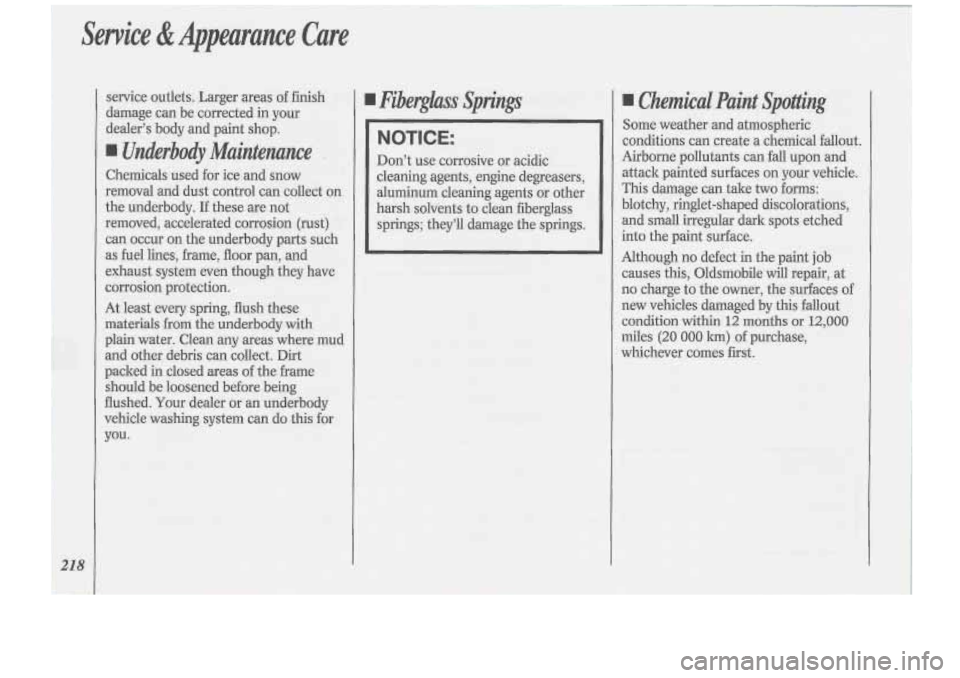
I
NOTICE:
Don't use corrosive or acidic.
cleaning agents, engine degreasers,
aluminum cleaning agents or other
harsh solv'ents to clean fiberglass
springs; they'll damage the springs.
1
I Chemical Paint Spotting